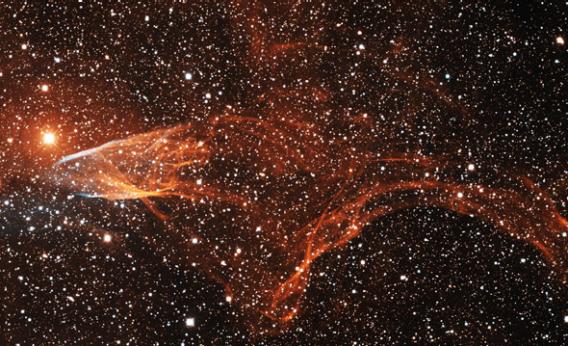Create a free profile to get unlimited access to exclusive videos, sweepstakes, and more!
How Did the Bald Eagle Nebula Hatch?

You’d think that by now—with dozens of telescopes on, above, and below the ground, observing the skies from all latitudes and longitudes, and having centuries of time in which to work—every object in the sky would be cataloged and understood.
But that’s not the case. Not at all. There are still plenty of weird beasties to tease out of the dark, astronomical oddities hiding in plain sight. One of them is G 70.5+1.9, which is way prettier than its catalog-generated name might suggest. Here’s the proof:
That gorgeous photo is by my pal Travis Rector, who noticed it at the edge of another nebula he was observing. Travis notes it looks like a bald eagle in flight, the bright head to the left, the bluish strands outlining the beak. I have to agree. You can even see a wing above it, the tail behind, the taloned feet below! The prosaic name notwithstanding, I think The Bald Eagle Nebula is a far better moniker for it.
Right away I figured it for an old supernova remnant. When a star explodes, a lot of gas is expelled into space at a ferocious clip. It slams into the gas surrounding it, creating huge and powerful shock waves. This compresses the gas and makes it glow. As the remnant ages it can look like a loose circle of filaments that interweave like a wicker wreath (some very massive stars can create similar structures on a smaller scale). The Veil Nebula is an excellent example of this, as is the Pencil Nebula.
But there’s a monkey in the wrench here. Most old supernovae remnants give off radio waves and X-rays, the result of the shock waves moving through the gas. The Bald Eagle Nebula shows no real signs of either. That’s weird. It’s not totally unprecedented—a handful of other SNRs are also radio and X-ray quiet—but it’s unusual.
One reassuring measurement does fit the bill, though. Different elements in the gas emit different colors of light, allowing us to measure the relative abundances of the elements in the gas—for example, Travis’ picture was taken using filters that isolate light from hydrogen (red) and oxygen (blue). Different types of objects (like gas blown out by young stars, or gas forming new stars) tend to have different element ratios in them, and emit light differently. Astronomers who observed this nebula noted that the light emitted is far more consistent with an exploded star than anything else.
So it does look like this is the last raging scream of a star that died long ago, sending its innards into outer space. As these things go it’s relatively close, likely less than 3,500 light years away. That’s still too far away to have directly affected us here on Earth, but I wonder if anyone, long ago, noticed a bright “new” star appearing in the constellation of Cygnus one summer, and gawked at it over the nights as it outshone Venus, then faded away over the ensuing weeks.
It must have been a total mystery to them … but then, it’s still somewhat of a mystery to us, too. That’s actually pretty cool. If we solve all the mysteries of the Universe, what fun will there be left for us to discover?
Travis is an accomplished professional astronomer as well as an artist when it comes to imaging; you could do a whole lot worse than spending some time perusing his magnificent gallery of astronomical beauties.


























